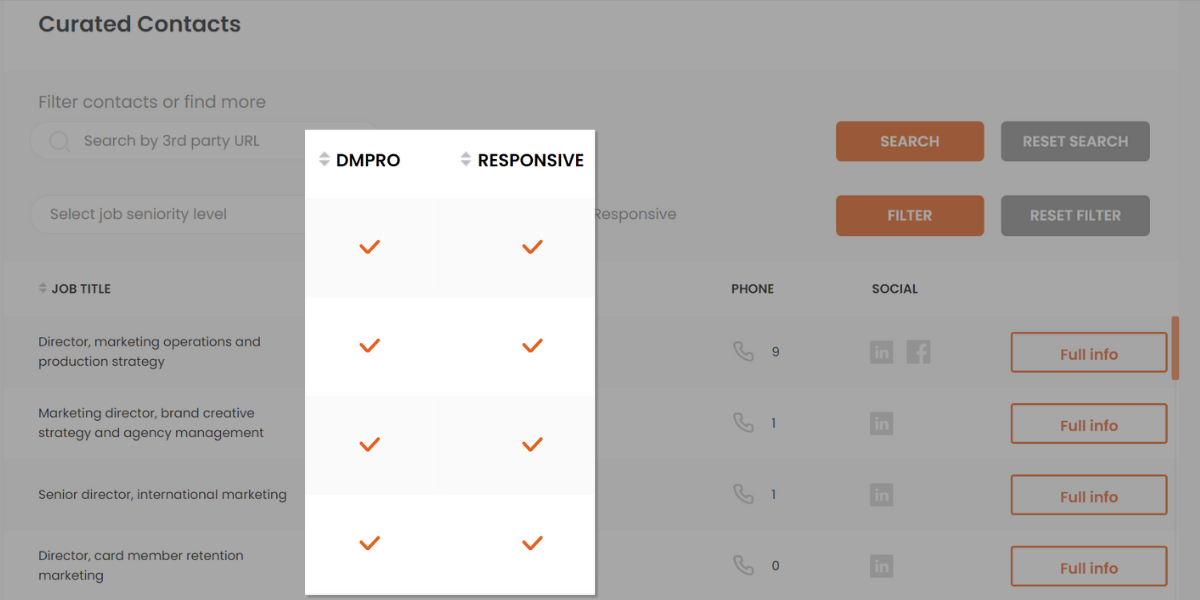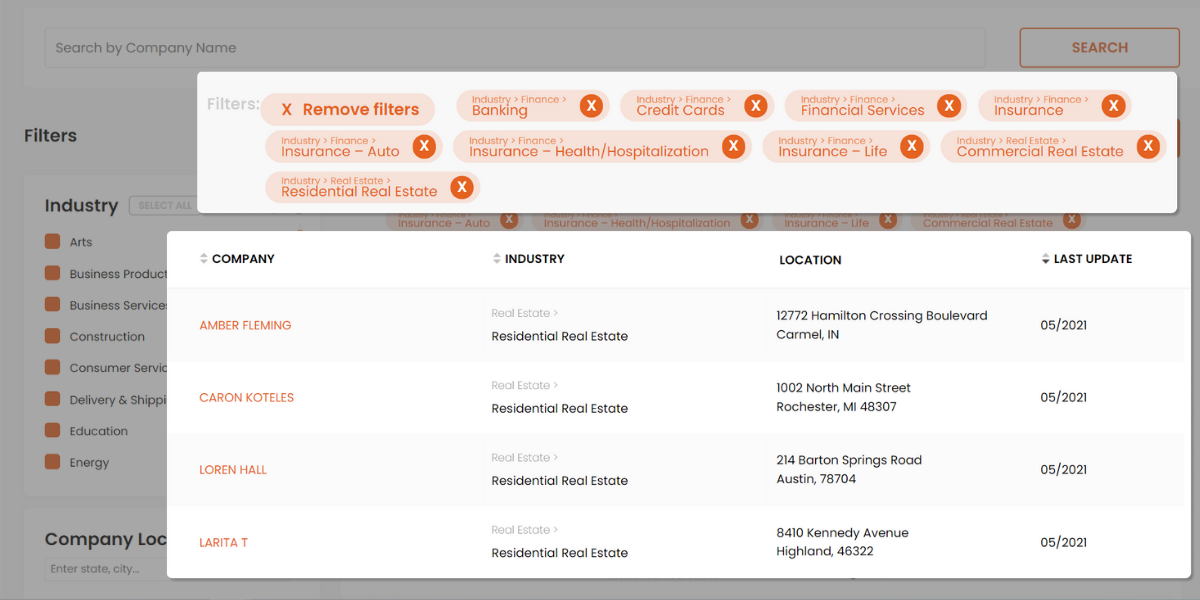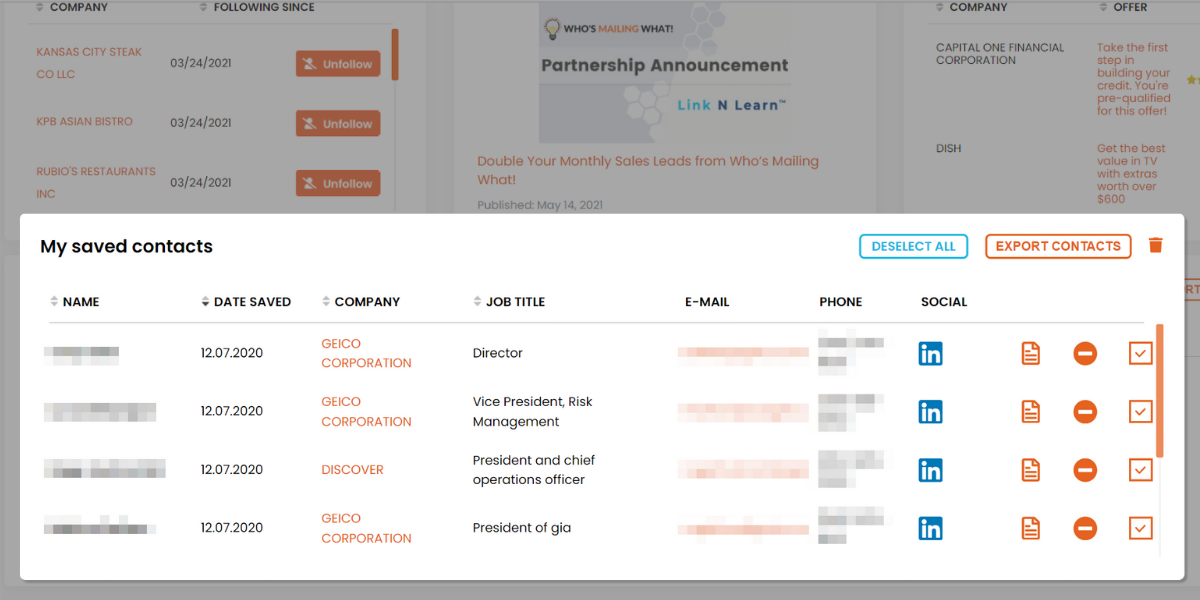WMW! NEWS
Who’s Mailing What! vs Winmo
In this article, we’re comparing 2 effective business intelligence tools for marketing – Who’s Mailing What! and Winmo.
While both Who’s Mailing What! and Winmo are positioned as effective business intelligence tools for marketing, the products are somewhat different.
We examined the other tools in this space, Comperemedia and Competiscan, which are services for tracking creatives in Direct Mail Marketing campaigns. Who’s Mailing What! proved to be especially competitive to the other options for the direct mail channel and was much stronger in identifying firmographic data and decision-maker contacts. Winmo comes in on the other side of the spectrum. While they do not provide much access to creatives (and particularly for direct mail marketers) they have a strength when it comes to tracking contacts at companies and agencies who do general advertising at a national level.
Overview
It is important to understand that comparing these products against each other side by side may seem a bit like comparing apples and oranges.
While Who’s Mailing What! focuses specifically on the direct mail industry, Winmo is focused on being a contact database for the general advertising industry. As a result, the creatives provided in Winmo are limited, reducing the ability to identify advertisers by the type of direct mail formats utilized.
Winmo Review
Winmo is primarily a sales prospecting tool. It is designed for tracking information including brand contacts, agency contacts, brand and media spend information, planning and buying cycles, as well as for tracking firmographic information for target companies, brands, and agencies.

Winmo provides agency rosters for brands, and client rosters for agencies, and has information about where brands and companies are spending money. They maintain data on approximately 12,000 different companies marketing across a variety of channels. This number may not seem particularly large, particularly against Who’s Mailing What! which adds hundreds of newly identified mailers every month to the 22,000+ direct mail specific marketers monitored. This is because Winmo only tracks larger companies, or those that spend at least $750K per year or generate more than $50M a year in revenue.
One thing that is important to note is that, apart from detailed contact information, everything in Winmo is from a third party. Their contact database is their primary selling point, and they have extensive intelligence about these contacts.
Who’s Mailing What! Review
WMW! on the other hand, provides a considerable database of not just contacts, but also a rich history of creative campaigns, where one can see exactly how different entities spend their money on direct mail. One can use it as a tool for recognizing what types of campaigns are effective, given comprehensive analytic tools including tracking which campaigns have been repeated over time (through identified controls and grand controls).

WMW! in contrast to Winmo, gathers information on its own, and has contact data that is fairly strong when matched up against Winmo. For example, WMW! has a proprietary DMPRO flag to select those contacts working on direct mail campaigns. WMW! also tags those contacts who are more likely to respond to social media outreach. These features give WMW! a strong edge if one’s purpose is finding contacts at companies who use Direct Mail with which to do business.

WMW! provides access to more than 50,000 contacts, with thousands more added monthly. These contacts are associated specifically with companies who engage in direct mail marketing. Each contact record is associated with a list of campaigns, including full metadata about when each campaign was sent, to whom, and includes all materials sent along with these campaigns, including envelopes and creative content.
The Number of Brands/Marketers Identified in a Month
The numbers for Winmo are not particularly high, but this is largely due to the strict criteria that they use for what types of companies are stored in their database. Winmo largely looks at those companies likely to be the most active marketers. In this sense, they are different from WMW, which takes a blanket approach toward which companies to track. Since the data that WMW! works with is recipient-level driven, you are more likely to get a broader view of the overall landscape of direct marketing.
Winmo instead chooses to focus on the cream of the crop. They do, however, track some “emerging” companies. These include some smaller companies that are spending a significant amount of money.
Under “Emerging” companies, they provide scores, based on imminence. The higher the number the more likely a company is likely to make major changes to their marketing campaigns and to become a major player. These scores can show vulnerability for companies, such as those likely to go through full creative reviews.

They provide a listing of which companies are new to the index. They also provide information about companies that fell off the index, and those that have the highest scores.

Data stored within Winmo is kept relatively up to date; it is not a tool for tracking historical behavior. They have a 60-day rotation on information stored in the database.
WMW, in contrast, provides a long history of data, and one can track trends that occur within campaigns. WMW! captures up to 15,000 scans per 90 days from many different organizations. This includes information from approximately 200-250 newly identified advertisers per week; WMW!’s database keeps growing.

Conclusion
When it comes to sheer numbers, WMW! clearly tracks a much larger number of mail marketers.
Industry Selection
Both Winmo and WMW! have strong categorization of different industry segments.

This is comparable to the listing of companies that WMW! provides, and the categories used are similar. Both products organize categories according to NAICS codes. Here is the full list of the industries Who’s Mailing What! covers.

Conclusion
Since both use NAICS for marketer industry categories, this can be considered a tie.
B2B Tracking
Winmo tracks about 1200 companies that fall within the B2B space. If narrowed down, we can find about 1,000 B2B companies that have approximately 9,000 contacts in B2B in Creative or Marketing. While the number of companies listed may not be a large number, they tend to be among the largest players.
WMW! provides access to over 18,000 B2B campaigns.
![]()
Conclusion
Both services are predominantly B2C concentrated, but both have coverage of B2B as well.
Agency Identification
Winmo does agency and brand mapping internally. Narrowed down by brand, we can get about 1800 brands with the same criteria, however it appears that there are only about 3500 individual contacts. Under agencies, we can see contacts at an agency, what brands they service, and with whom they work, listed under client relationships. They also provide access to the full client roster of these agencies.
WMW! does not link agencies to marketers. What WMW! does especially well is identifying agencies that do direct mail marketing, as well as the appropriate contacts within those agencies. WMW! has more than 20,000 decision makers available at agencies that have a focus on direct mail.
Conclusion
For general advertising, Winmo does a great job maintaining comprehensive linkage between brands, agencies and associated contacts. However, given the fact that there are no agencies identified as working specifically with direct mail, WMW! is a great resource for the direct mail advertising industry.
Сampaign Performance Identification
Winmo is really not this type of a tool; they do not track campaigns except peripherally through some of their third-party tools. They don’t track user-level data, so this is not really a fair comparison with WMW! Winmo simply doesn’t offer this feature. At their highest levels of membership, they do provide information about how much companies are spending on their campaigns and you might be able to infer which are the best performing based on budgeted spend.
WMW! has detailed information including a Performance Score and identified controls and grand controls tracking which campaigns are most likely to have performed well. WMW! also has some distinct analytics for identifying common characteristics of effective campaigns, and with an enterprise membership you can get access to professional analysts who can help make clear determinations about which criteria have been used to generate positive campaign success.

Conclusion
This may seem a bit unfair, as Winmo does not offer this type of analysis. They do not have a horse in this race, so WMW! wins by default.
Direct Mail Focus
The primary channel for brands and companies that Winmo focuses on is digital marketing. They do have approximately 950 companies which list direct mail as one of their marketing strategies. For these companies, they list over 27,000 direct contacts.

In comparison, WMW! is focused primarily on direct mail marketers and agencies. WMW! has more than 60,000 contacts available between mailers and their agencies, representing more than 21,000 organizations working with direct mail.

For Winmo, creatives are essentially samples that have been analyzed in their articles that they have created. None of the creatives that they offer are for direct mail.
Their access to creatives from other channels is through a third-party: AdForm. You can search by brand, media, country, business sector, agency name, awards, etc.
Adform provides creatives for the following verticals:
- Television and Cinema
- Outdoor
- Digital
- Case Study
- Magazine
- Web Firm
- Direct Marketing
- Radio
- Packaging, Branding, Design
It is also possible to see how much companies are actually spending over a period of time through a partnership with Pathmatics, where you can find detailed information about how much is spent in which marketing channels.

WMW!, in direct comparison, is focused on the direct mail market.
Conclusion
WMW!, if your focus is direct mail, wins by a landslide.
Creative Insights
Winmo has a publication with content that they write and share directly with their clients. These articles describe where money has been spent, and which channels have been used. Creatives link into actual records, but they are dependent on third-party information and custom created articles.
At the highest levels of access, they have detailed information about how much is spent in which marketing channels. It’s worth noting that access to creative insights is not available at the lowest level of membership.
WMW! provides a regular column of articles, including regular analysis of market trends, however, it does not provide access to the types of third-party tools that Winmo provides. If you have the budget, you can get access to trained data scientists at WMW! who can provide custom access to detailed analytics including across channels.
Conclusion
At higher membership levels, both companies provide sophisticated analysis; Winmo with their third-party analytical tools, and WMW! with the team of analysts.
The services provided are somewhat different, so it’s hard to do a side-by-side comparison, this is deemed to be a tie due to the two companies being in different races.
Contact Information
Winmo provides basic contact information for each individual within its database
- Phone
- LinkedIn URL
However, particularly interesting is the information obtained through Crystal Knows reports. With this, Winmo is able to provide detailed information about personality types, and quick tips about best outreach style. This is data which helps determine whether individuals are more personable, vs. buttoned up, etc. With this data they provide full DISC assessments (a measurement of different personality types). This type of data can be helpful for sales personnel.
WMW! provides some nice tools for contacts as well. WMW! focuses primarily on tracking management contacts who are part of the direct mail decision making process. The WMW! proprietary DMPRO selection to target direct mail practitioners is unique. WMW! also has a powerful tool for identifying which contacts are most likely to respond, based on social media activity.

One of the strongest features of WMW! is the ability to search for mail advertisers based on the type of mail advertising they send. For example, if you want to reach real estate postcard mailers, these advertisers are readily identifiable. As another example, if you are seeking advertisers sending sales letters for mortgage refinancing offers, a search on WMW! produces more than 6,000 campaigns sent by hundreds of marketers.

Conclusion
Due to the volume of contacts available in the database, and the Crystal Knows reports, and considering that contacts are the primary focus of Winmo’s business, they get a win here if your goal is to reach the maximum number of contacts in the advertising industry. That is their strength. However, considering that WMW! provides access to many more companies and agencies that actually do direct mail marketing, and that the contacts tracked by WMW! are the people you want to be reaching out to for direct mail related outreach, WMW! is the clear choice for the direct mail industry.
Available Integrations
Winmo allows downloading contacts in the following formats:
- CSV
- Excel
- Salesforce
- Hubspot
- Dynamics
However, there are limits to the number of exported records based on membership level. If you need to download more than 7500 contacts into an external system, you need to pay a bit more.
WMW! allows downloading contacts in CSV format. WMW! memberships offer both limited and unlimited options to access organizations and contacts.

Conclusion
Both services have membership plans to address the data access needs of different levels of users. Winmo has more data formatting options, but it is easy to import into any platform from the output provided by WMW!
Winmo Pricing
Winmo pricing is subscription based. Winmo has a starter package, which comes without the Winmo Edge monitoring service, and no custom research requests, at $7,500 per year. Their standard service level is $10,000 per year including 8 research requests. A research request provides the ability to get data on an advertiser not well documented in the Winmo platform. Winmo’s highest level package, “Explorer”, comes with all of their partner enhanced data options, including Pathmatics for reporting on digital media spend. This brings the service to $18,000 to $40,000 annually, depending on options selected.
Who’s Mailing What! Pricing
The investment in WMW! can be as little $999 per year for a single industry category and the investment tops out at $14,900 for an Enterprise level unlimited access membership. WMW! membership options are tiered based on the number of users and the number of contacts accessed.
Conclusion
While it is a bit confusing to do an exact comparison, buyers comparing the two services report that WMW! comes in at an investment level 45-65% lower than Winmo. But price is not the main deciding factor. If access to the general advertising industry is the goal, Winmo is the best option. If reaching the direct mail marketing industry is the goal, using WMW! is the clear decision.
Summary
The two services are quite different from each other, with WMW! focusing on direct mail advertising and Winmo focusing on the general advertising industry. In fact, there is very little overlap between the two. Some subscribers join both services. If your mission is to reach direct mail marketers, the decision is easy, as Winmo only provides access to less than 1,000 direct mail brands compared to more than 22,000 tracked by Who’s Mailing What!, with hundreds more added every month.

































